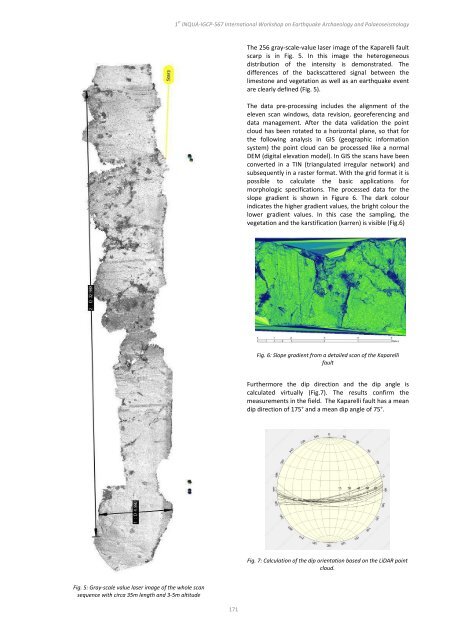Archaeoseismology and Palaeoseismology in the Alpine ... - Tierra
Archaeoseismology and Palaeoseismology in the Alpine ... - Tierra
Archaeoseismology and Palaeoseismology in the Alpine ... - Tierra
You also want an ePaper? Increase the reach of your titles
YUMPU automatically turns print PDFs into web optimized ePapers that Google loves.
Fig. 5: Gray‐scale value laser image of <strong>the</strong> whole scan<br />
sequence with circa 35m length <strong>and</strong> 3‐5m altitude<br />
1 st INQUA‐IGCP‐567 International Workshop on Earthquake Archaeology <strong>and</strong> <strong>Palaeoseismology</strong><br />
171<br />
The 256 gray‐scale‐value laser image of <strong>the</strong> Kaparelli fault<br />
scarp is <strong>in</strong> Fig. 5. In this image <strong>the</strong> heterogeneous<br />
distribution of <strong>the</strong> <strong>in</strong>tensity is demonstrated. The<br />
differences of <strong>the</strong> backscattered signal between <strong>the</strong><br />
limestone <strong>and</strong> vegetation as well as an earthquake event<br />
are clearly def<strong>in</strong>ed (Fig. 5).<br />
The data pre‐process<strong>in</strong>g <strong>in</strong>cludes <strong>the</strong> alignment of <strong>the</strong><br />
eleven scan w<strong>in</strong>dows, data revision, georeferenc<strong>in</strong>g <strong>and</strong><br />
data management. After <strong>the</strong> data validation <strong>the</strong> po<strong>in</strong>t<br />
cloud has been rotated to a horizontal plane, so that for<br />
<strong>the</strong> follow<strong>in</strong>g analysis <strong>in</strong> GIS (geographic <strong>in</strong>formation<br />
system) <strong>the</strong> po<strong>in</strong>t cloud can be processed like a normal<br />
DEM (digital elevation model). In GIS <strong>the</strong> scans have been<br />
converted <strong>in</strong> a TIN (triangulated irregular network) <strong>and</strong><br />
subsequently <strong>in</strong> a raster format. With <strong>the</strong> grid format it is<br />
possible to calculate <strong>the</strong> basic applications for<br />
morphologic specifications. The processed data for <strong>the</strong><br />
slope gradient is shown <strong>in</strong> Figure 6. The dark colour<br />
<strong>in</strong>dicates <strong>the</strong> higher gradient values, <strong>the</strong> bright colour <strong>the</strong><br />
lower gradient values. In this case <strong>the</strong> sampl<strong>in</strong>g, <strong>the</strong><br />
vegetation <strong>and</strong> <strong>the</strong> karstification (karren) is visible (Fig.6)<br />
Fig. 6: Slope gradient from a detailed scan of <strong>the</strong> Kaparelli<br />
fault<br />
Fur<strong>the</strong>rmore <strong>the</strong> dip direction <strong>and</strong> <strong>the</strong> dip angle is<br />
calculated virtually (Fig.7). The results confirm <strong>the</strong><br />
measurements <strong>in</strong> <strong>the</strong> field. The Kaparelli fault has a mean<br />
dip direction of 175° <strong>and</strong> a mean dip angle of 75°.<br />
Fig. 7: Calculation of <strong>the</strong> dip orientation based on <strong>the</strong> LiDAR po<strong>in</strong>t<br />
cloud.



